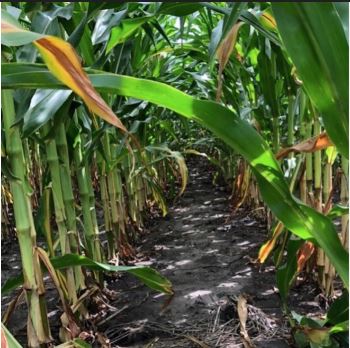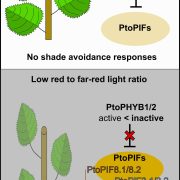Real Smart Canopies: How Do Maize Canopies Respond to Shading?
Zhou et al. explore how maize plants adjust their canopy architectures at high plant densities to tolerate shading from adjacent plants.
https://doi.org/10.1093/plcell/koae007
Yan Zhou, Iowa State University
Background: The dramatically increased yields of commercial maize hybrids are largely a consequence of improved tolerance to high plant densities. At high plant densities, adjacent plants can shade each other, reducing light penetration into the canopy and yields. Dicots, such as tomato and Arabidopsis, respond to shading by producing leaves that are more upright. Maize does not respond to shading in this manner.
Question: At high plant densities, how do maize plants adjust their canopy architectures to tolerate shading from adjacent plants?
 Finding: We report on the ability of some maize genotypes to alter the azimuthal orientations of their leaves during development in coordination with adjacent plants. Although the upper canopies of these genotypes retain the typical alternate-distichous phyllotaxy of maize, their leaves grow parallel to those of adjacent plants. A genome-wide association study conducted on this parallel canopy trait and on the fraction of intercepted photosynthetically active radiation identified candidate genes, many of which are associated with shade avoidance syndrome and ligule development, such as liguleless1 (lg1). Further, mutagenesis studies demonstrated liguleless gene functions are required for normal light responses, including azimuthal canopy re-orientation.
Finding: We report on the ability of some maize genotypes to alter the azimuthal orientations of their leaves during development in coordination with adjacent plants. Although the upper canopies of these genotypes retain the typical alternate-distichous phyllotaxy of maize, their leaves grow parallel to those of adjacent plants. A genome-wide association study conducted on this parallel canopy trait and on the fraction of intercepted photosynthetically active radiation identified candidate genes, many of which are associated with shade avoidance syndrome and ligule development, such as liguleless1 (lg1). Further, mutagenesis studies demonstrated liguleless gene functions are required for normal light responses, including azimuthal canopy re-orientation.
Next steps: Conduct experiments to investigate the roles of auxin and blue light induced phototropism in azimuthal canopy reorientation in maize.
Reference:
Yan Zhou, Aaron Kusmec, Patrick S. Schnable. (2024). Genetic regulation of self-organizing azimuthal canopy orientations and their impacts on light interception in maize. https://doi.org/10.1093/plcell/koae007





